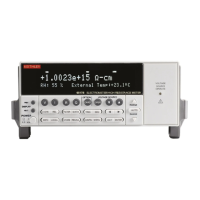Section 9: Filters and math Model 6517B Electrometer Reference Manual
9-2 6517B-901-01 Rev. C / August 2015
Digital filters
Digital filter types
The Model 6517B has two types of digital filters: averaging and advanced. Both types are a simple
average of one to 100 reading conversions. The difference between them is the user-programmable
noise "window" of the advanced filter.
The noise window, which is expressed as a percentage of range (0-100 %), allows a faster response
time to large signal step changes (for example, scanned readings). A reading conversion outside the
plus or minus noise window fills the filter "stack" immediately.
If the noise does not exceed the selected percentage of range, the reading is based on an average of
reading conversions. In this case, the advanced filter works the same as the averaging filter. If the
noise does exceed the selected percentage, the reading is a single reading conversion, and new
averaging starts from this point. The two filter types are compared in the figure in Median filter (on
page 9-3).
Digital filter modes
An additional filter parameter is the mode, either moving or repeating. A moving filter is a first-in, first-
out stack, where the newest reading conversion replaces the oldest. An average of the stacked
reading conversions yields a reading. Therefore, after a selected number of conversions, a moving
filter gives a new reading for every new conversion.
A repeating filter takes a selected number of reading conversions, averages them, and yields a
reading. It then flushes its stack and starts over. This characteristic is useful when scanning channels.
Filter modes are compared in Median filter (on page 9-3).
Response time
The various filter parameters have the following effects on the time needed to display, store, or output
a filtered reading:
Filter type: The time to the first reading is the same for all filters; moving mode yields a faster
reading than repeating mode. Also, advanced mode has a faster response to changes in the input
signal than averaging.
Number of reading conversions: Speed and accuracy are inversely dependent (for example,
greater speed results in reduced accuracy).
Noise window: For the advanced type, speed, accuracy, and response to input signal changes
are related in the same way as speed and accuracy in the number of reading conversions.

